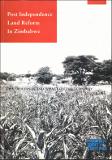| dc.contributor.author | Mubvami, Takawira | |
| dc.coverage.spatial | Zimbabwe. | en |
| dc.date.accessioned | 2016-04-01T15:45:37Z | |
| dc.date.available | 2016-04-01T15:45:37Z | |
| dc.date.issued | 2004 | |
| dc.identifier.citation | Mubvami, T. (2004)Impact of land redistribution on the environment. In: Masiiwa, M. (ed.) Post-independence land reform in Zimbabwe: controversies and impact on the economy. Harare: Friedrich Ebert Stiftung and Institute of Development Studies, University of Zimbabwe, pp. 71-90. | en |
| dc.identifier.isbn | 0797427864 | |
| dc.identifier.uri | https://opendocs.ids.ac.uk/opendocs/handle/20.500.12413/10399 | |
| dc.description | A position paper on the impact of land distribution on the Zimbabwean Eco-system particularly its effects on rural development programmes. | en |
| dc.description.abstract | Environment degradation and sustainability of resettlement schemes has been a concern of most among the donor community based on their responses to the proposals presented at the Donor Conference. Government proposals argued that resettlement will lead to intensification of land utilisation as well as bring into production land that has hitherto been idle. Settlers who predominantly are for communal farmers use firewood as source of energy. Given this, it is expected that resettlement would lead to high rates of deforestation. Further settler households bring with them poor animal husbandry practices that have led to land degradation in communal areas. Generally, bringing together farmers from different areas destroys the traditional structures that helped in resource conservation, and the diversity of these farmers precludes emergence of such structures under resettlement.
However, some have argued that because of lack of resources settler families have only achieved a fraction of land utilisation practised by former commercial farmers. Also because most of them are poor there is less animals per unit area compared to an average communal area. Thus arguments that resettlement invariably leads to land degradation are baseless.
This chapter seeks to review the environmental impacts of the fast track land reform on the biophysical environment. Other aspects of the environment i.e. socioeconomic have been addressed elsewhere in this volume. This chapter begins with a quick synopsis of the impact of the programme on land cover (vegetation), soils and water. It also looks at issues of the institutional set up for the management of natural resources in the resettlement areas and concludes by recommending some framework for improving the management of natural resources in resettlement areas. | en |
| dc.description.sponsorship | Friedrich Ebert Stiftung Foundation. | en |
| dc.language.iso | en | en |
| dc.publisher | Friedrich Ebert Stiftung and Institute of Development Studies, University of Zimbabwe, Harare, | en |
| dc.rights.uri | http://creativecommons.org/licenses/by-nc-nd/3.0/ | en |
| dc.subject | Environment | en |
| dc.subject | Rural Development | en |
| dc.title | Impact of land redistribution on the environment | en |
| dc.type | Book chapter | en |
| dc.rights.holder | © This collection: Medicine Masiiwa, Friedrich Ebert Stiftung and Institute of Development Studies, University of Zimbabwe | en |


